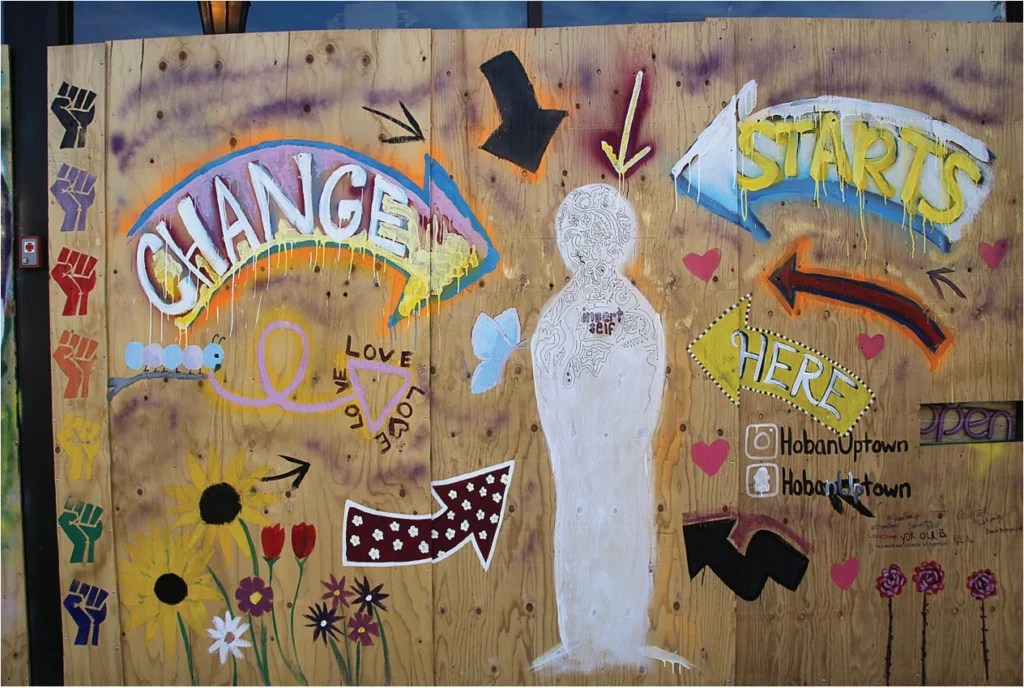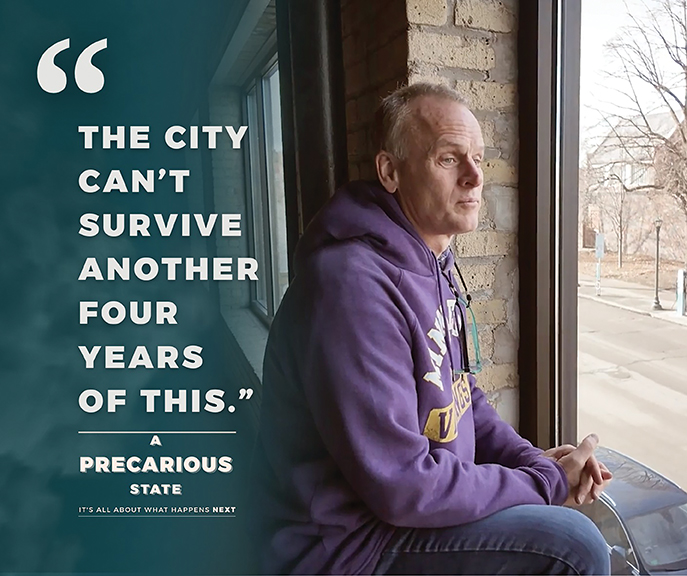“I think everybody in Minneapolis ought to own a little piece of property. To my mind, to own your own home is a duty which you owe to your children. Children that live in tenements have not the proprietary air of children who live in their own home, and it sticks to them.” So read a promotional advertisement in February 1915 for a new housing development in Columbia Heights. This “lovely” sentiment was penned by Edmund Walton (1865- 1919), a real estate developer who often sang the praises of buying a home in Minneapolis. He himself had emigrated to the Midwest in the 1880s from London and settled permanently in Minneapolis in a home on Mount Curve Avenue after making his fortune in residential real estate. One would think that Walton truly stood for home ownership and the benefit of home investment for the working man. In reality, Walton’s legacy is a lasting stain on Minneapolis.
In May 2020, 105 years after this advertisement, more than 1500 businesses were damaged or destroyed in the civil unrest following George Floyd’s murder. These businesses served a predominantly Black and immigrant population. A question often heard was why people loot and destroy their own neighborhoods. Perhaps the segregated neighborhoods begun by Edmund Walton and the subsequent unfair housing practices have something to do with the destruction.
When Edmund Walton arrived in Minneapolis in 1890 to work for Thomas Lowry, the city was the 18th American city in size with 37% of the population foreign-born. The city was also one of the most integrated in the country. Edmund Walton would help change that. While he was promoting the importance of home ownership, he did not intend this privilege for all. He was actively creating a real estate policy that would prevent nonwhites from buying homes in certain areas of Minneapolis. He promoted an idea that property values would deteriorate if nonwhite people lived in these neighborhoods. In 1910, Walton introduced the racial covenant into his Minneapolis home deeds and changed the city into the segregated one it still is today.
Covenants are restrictive language attached to a property that dictates how a property can be used, such as restricting short-term rentals or chickens in a residential neighborhood. However, the racial covenant limited who could live in a neighborhood by placing a clause in the home deed that said something like “the said premises shall not at any time be sold, conveyed, leased, or sublet, or occupied by any person or persons who are not full bloods of the so-called Caucasian or White race.” This was a common Minneapolis covenant employed by Edmund Walton and other real estate developers when many immigrants and people of color were seeking a better life in Minneapolis. The population of Minneapolis was 202,718 in 1900 and grew to 380,562 in 1920. This population growth would hold steady, but the demographics would shift. The percentage of foreign born would decrease from 20% in 1910 to 3% in 1970. In 1915 the Great Migration brought Black families who were trying to escape Jim Crow prejudice and limitations. However, they encountered Jim Crow in northern cities as well but in subtler ways, one being the real estate racial covenant. This geographical constraint pushed Black people into less desirable areas of the city with an inferior quality of life and not the one they had hoped for in their recent inclusion in “the right to life, liberty, and the pursuit of happiness.”
The racial covenants were not unique to Minneapolis. Many cities were placing them in the home deeds. In 1926, in Corrigan v. Buckley the United States Supreme Court upheld the racial covenant as a legally binding document between private parties. As a result of the ruling, there was an increase in racial covenants around the country. Finally, in 1948, the Supreme Court ruled in Shelley v. Kraemer that a racial covenant was not enforceable, as it violated the 14th Amendment. Although this decision was seen as a civil rights victory, it did little to change what was an established disparity in wealth and opportunity. Other racist housing practices had come into effect that exacerbated the problem of finding a place to live for people of color.
In the Great Depression, the increase in mortgage defaults and foreclosures led to government intervention in order to stabilize the housing market. At first glance, the federal government’s actions seemed prudent. As Nancy Welsh explains in her paper Racially Restrictive Covenants in the United States: A Call to Action, “the National Housing Act of 1934 that created the Federal Housing Authority (FHA) was able to stabilize the housing market by insuring low-interest, fully amortized, twenty-year loans. Before receiving an FHA-backed mortgage, a property was required to meet appraisal standards, including racial exclusivity. The FHA’s 1935 underwriting manual stated, ‘If a neighborhood is to retain stability it is necessary that properties shall continue to be occupied by the same social and racial classes. A change in social or racial occupancy generally leads to instability and a reduction in value.’” The neighborhoods that were already less desirable or valuable but still the ones that people of color needed to live in were subjected to redlining, a banking practice that made it impossible to get loans for properties in racially mixed neighborhoods as they were seen to be higher risk. Other racist banking practices created more requirements for Black people seeking a mortgage because of the accepted but undocumented idea of being a greater risk.
Edmund Walton had an easier experience as a newcomer to Minneapolis. As a White man, he arrived and was able to build a successful real estate company in a short time. One of his first independent real estate enterprises was the purchase and development of Walton Hills, the neighborhood between Lake of the Isles and Cedar Lake. These home deeds would contain the racial covenants prohibiting “persons of Chinese, Japanese, Moorish, Turkish, Negro, Mongolian or African blood or descent” from buying. Walton would have a lucrative career and build a mansion on Mount Curve Avenue called Grey Court. Ironically, the home was decorated by John Bradstreet in the Moorish Revival style with art from Northern Africa and Spain. When he died at age 54, he was able to leave his wife and three daughters well off with an estate of $195,000 (about $3.2 million today).
The racial covenant did not have to be in the deed to have impact. If the racist language existed in an area, then other homeowners without the restrictive covenant were pressured not to sell to people of color. Even if a Black family did move into the neighborhood, the family could face mobs and violence, such as the Lee family did in 1931 when they moved into a white neighborhood in south Minneapolis. After two years, the Lees gave up their hope of living in the neighborhood and enjoying the schools and parks it offered and relocated to a historically Black neighborhood.

In 2018, a USA Today study ranked Minneapolis as one of the worst places to live for Black people. While 75% of White people own their home, less than 25% of Black people own theirs. Mapping Prejudice explains that “since most families amass wealth through property ownership, this homeownership gap continues to feed our contemporary racial wealth gap. Wealth is built through generations, with one generation passing resources to another. Thanks in part to the racial biases that have been baked into the real estate market over the last century, the average white household in the United States has ten times as much wealth as the average black household.”
Has your property’s value benefited from Edmund Walton’s racial covenants and subsequent redlining? You can probably answer this by answering a few follow-up questions. Do most of your neighbors own their homes? Does your neighborhood have good schools? Does your neighborhood have parks and bike paths? Are there commercial and industrial complexes in your neighborhood? Is there any government housing in your neighborhood? Are there grocery stores in your neighborhood? Are there fast-food restaurants in your neighborhood? How close are you to a landfill or garbage transfer station?
In the aftermath of the George Floyd protests, the Brookings Institute offered an explanation of why people destroy their own neighborhoods. “Our research has documented that homes and businesses located in Black-majority neighborhoods are significantly undervalued relative to their quality. In other words, racism has depressed the market value of property whenever it comes near Black people. Thus, there is a cost-benefit logic undergirding why demonstrators set fire to buildings and businesses: It’s not counterintuitive to destroy property that isn’t valued by society. The devaluation of Black lives fuels the flames in our cities. To convince protestors not to burn down buildings, we must restore the value that racism has extracted from them.”
For more information about racial covenants and how to remove the language from a deed, please visit Mapping Prejudice at https://mappingprejudice.umn.edu/.






